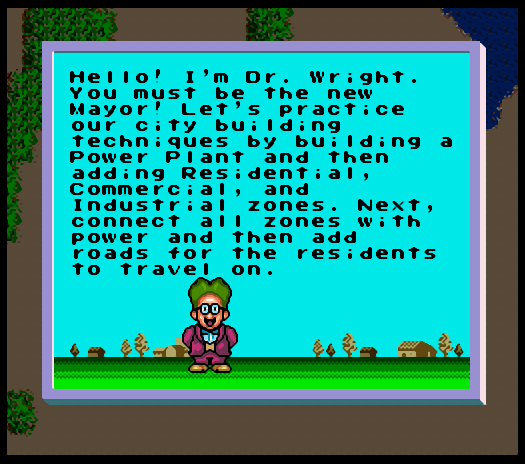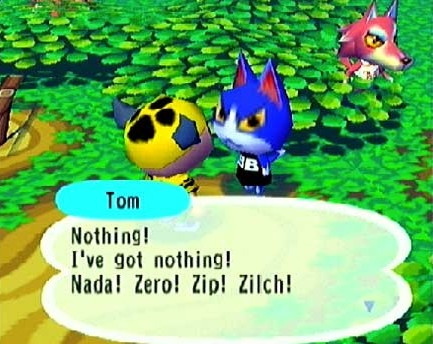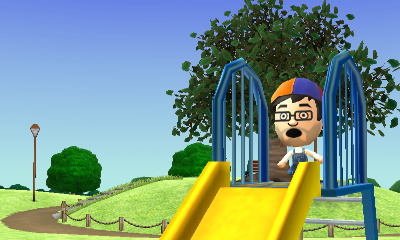The Western release of Tomodachi Life has been met with a surprisingly large amount of publicity. Granted, at least some of that was due to unexpected controversy, but as that discussion died down, popular interest remained.
The rise of the life simulation genre is one of gaming's most interesting puzzles. In a medium that built itself on unprecedented interactivity and literally boundless potential for action and adventure, the relatively passive experience of caring for an animal, a town, a field of crops, or even a little cartoon version of yourself, has become big business.
What's more, it's done so quietly. True to the nature of the genre itself, its rise to success has been an almost passive one. Which is why we'd like to look back on Nintendo's unexpected – but welcome – devotion to the blank canvas.

CONTROL: Sim City (SNES, 1991)
When it comes to shaping a successful life sim, and in turn figuring out why they appeal to so many gamers who are otherwise surrounded by louder, flashier, larger games, three key aspects of game design come to mind: Control, Engagement, and Emotion. We'll discuss each of these in turn, filtering them through one of Nintendo's own titles.
Fittingly enough, “Control” is perhaps best exemplified by a game Nintendo developed, but didn't actually create: the SNES version of Sim City.
Subscribe to Nintendo Life on YouTube841k
While far from the first simulation game, the 1989 PC version of Sim City is nevertheless the most important from a historical standpoint. It took the nichest of niche concepts, and turned them into a global phenomenon that's still popular today. City zoning, traffic control and tax allocation certainly don't sound like exciting bullet points on the box of a hit game, but Sim City was such a hit that it caught the eye of Nintendo, which was not only riding its own wave of hardware popularity, but had cemented itself as a major creative force within the industry.

It would have taken one heck of an idea to get its attention, but Sim City was absolutely that idea. Nintendo took the formula that had been proven to work and kept it more or less intact, while putting its unmissable stamp all over everything. The graphics were prettier, the music was gorgeous, a mess of new scenarios and buildings were introduced, a win condition was added, a cartoon-ready mascot was introduced (the winkingly named Mr. Wright), and Mario and Bowser both make cameos.
This was Nintendo's first taste of true simulation success, and it's obvious that it liked it. Sim City on the SNES was every bit as well-received as the PC game, and many fans still consider it to be the best version of the game, period. Granted, it wasn't a life simulation, but Nintendo's tweaking almost turned it into one. By putting the recognizable Mario and Bowser into the game, and by giving us charming ground level views of Dr. Wright reacting to our decisions, the SNES version of Sim City shrewdly de-anonymizes the experience. On PCs, your residents were pixels. On the SNES, we got the sense that they were people. It was a major – yet subtle – difference.
Sim City remains popular due to just how much control you have as a player. Later games in that series increased the amount of variables and options, but as later spinoffs (such as Streets of Sim City, and, of course, The Sims) confirmed, the real heart of the game is in the people that populate your city.
Nintendo was possibly the first to realize that. As much fun as it was to exercise your control for either good or evil (because, seriously, that Bowser attack was COOL), we only stayed engaged because we could imagine there were actual people there.
And speaking of which...

ENGAGEMENT: Animal Crossing (N64, 2001 / GC, 2004)
Nintendo's next major foray into life simulation came ten years later...in Japan. The rest of the world got to experience it after a further three years had elapsed.
Why the delay? Well, the amount of text was massive and may not have justified the cost of localization, but it's hard not to read a certain amount of skepticism on Nintendo's part into the fact that it waited for the next console generation. There was very likely a fear that its enormous success in Japan put to rest: the fear that this game was just too odd to sell.
After all, describing the plot of Animal Crossing is impossible. There really isn't one. Even describing the gameplay is difficult; you can either say too much and make it sound needlessly intimidating, or say too little and make it sound like a yard-work simulator.
But, really, it's Nintendo's Sim City, from the ground up. While zoning and sociological concerns are far less pressing in the Animal Crossing games, that doesn't change the fact that these games bridge the gap between city simulation and life simulation. Here, you are one of those little people living in the world constructed by somebody (or something) else's decisions. In Sim City, you had a definite goal. In Animal Crossing, you don't. Unless, of course, you count having fun.
The reason Animal Crossing is more fun to play than it is to hear about is that it traffics massively in engagement. Why are you digging holes? To find money. Why are you finding money? To buy everything you want in order to customize your house and appearance. Why do you want to customize your house and appearance? To show your friends.

Everything you do in Animal Crossing is almost insultingly without purpose...and yet is entirely purposeful. The game introduces a context in which the meaningless is given meaning, and the hollow made full. And it does this by making sure everybody's experience is different.
Different times of day provide different items to find and attitudes to encounter. Different times of year bring along their own holidays and unique goodies. Different stock is carried every day in the shop, making shopping a daily (and pressing) temptation. Different neighbours move in, and request different things of you. Heck, even the basic example above (“Why are you digging holes?”) can be answered with a different response entirely (“To enhance the museum.”).
It was – and is – a rolling sort of engagement. Successfully manoeuvring Mario through one of his adventures might be satisfying, but it's also the kind of experience that all of the players share. The moveset is the same, the objective is the same, and the rough sequence of levels is the same. Obviously that's not detrimental to Mario's popularity, but it does help something like Animal Crossing to stand out; every single player is playing a different game, for different reasons.
You and a friend could play Animal Crossing – any Animal Crossing – for a full year without experiencing much, if any, overlap. You'll know different neighbours. You'll have accumulated different furniture. You'll have the same buildings in eerily different places.
And that's why it works. The engagement is both personal (achieving your own goals) and social (setting new goals as you see what others have achieved).
Sim City's level of control gave substantial way to Animal Crossing's engagement, and Nintendo had another globally successful franchise on their hands.
But there's still one thing left to discuss, and it may be the most important (and difficult) aspect of them all.

EMOTION: Tomodachi Life (3DS, 2014)
Another ten years down the line, we have Tomodachi Life. And the balance has tipped yet again, this time toward the emotional.
Which makes sense, considering that the games we've discussed definitely trend inward. First we had an omniscient view of a city. Then we were given dominion over an avatar in a town. Now we have an island, populated, at first exclusively, with ourselves.
The Mii is mandatory. Nintendo doesn't want you playing with an avatar; it wants something that's recognizably YOU. And while there will certainly be players who design their Mii for the first time in order to play, the vast majority will already have one. What's more, they will have controlled that Mii through sporting events, mini-games, and fitness activities over as many as three consoles by this point. The connection exists. Maybe at first that Mii you created on Christmas morning was just a simple, silly caricature, but after years of living with it, and slowly associating it with who you actually are as a person, Tomodachi Life takes advantage of that history, and turns the entire simulation into an emotional powerhouse.
In Sim City your anonymous residents could be either happy or sad, but on the whole they couldn't amount to much more than a collection of statistics. In Animal Crossing, your neighbours had personalities. Desires. Fears. Feelings. But you were a voiceless everyman.
Here, in Tomodachi Life, you're you. Your Mii gets sick. Your Mii gets depressed. Your Mii gets hungry, lonely, and cold. Each of these three games pulls mainly in a different direction to keep you playing, and Tomodachi Life pulls at your emotions: you want your Mii to be happy because it's you.
Animal Crossing managed a good amount of emotion. Every player had his or her favourite neighbours or visitors, and it felt good to please them and bad to upset them. Undoubtedly most players have also traded items or performed activities together at least once, with family members or friends, allowing for genuine memories and a real-world emotional connection to be built upon this digital framework.

Tomodachi Life takes it further. You still need to check the shops daily, and you still get rewarded for being as talkative as possible, but your island is quickly populated with people. And not just any people...people you know. Family members. Friends. Significant others long gone. Acquaintances that have moved away. The Miis on your 3DS move in. They want things. And their happiness depends on you.
There's arguably even less of a goal in Tomodachi Life than there is in Animal Crossing, but playing it becomes an urgent necessity. What if your friends are hungry? What if this is the day that you can get them the red ballcap they've been asking about? What if one of them just wants to see your face?
In its original PC release, Sim City had no win condition. Nintendo – wisely or not – added one. It fit well with that games theme of control, but it's something their later life sims have stayed away from.
Once upon a time, objectives were mandatory components of gaming. A man scientist would release a slew of killer robots. A marble would have to be guided safely through an obstacle course. The president would be kidnapped by ninjas.
But through the years, Nintendo learned how to bring players back without relying on objectives. This is why Mario and Link are nearly always reaching for the same thing: it's not the thing they're reaching for that's important. It's the journey.
In Animal Crossing and Tomodachi life, there's nothing but the journey. Nintendo took a tentative step into the simulation genre by injecting win conditions...and then sagely pulled them right back out.
After all, there are enough people telling you what to do in the real world. Aren't video games supposed to give you a chance to relax?

Comments 12
Every time I see Dr. Wright from Sim City, all I can think of is that weird sound he makes as an assist trophy in Brawl. NNRREEEAOOHH!
@Miss_Dark , you hit it right on the head. Life sucks.
I imagine that it's for the same reason we played with dolls when we were little - simulating reality and being able to tweak it to our desires is fun.
The personal need to interact with real or unreal people or objects.
A life sim without fashion and dressing up is a life sim I do not want to play.
I think the addictive fun of life Sim games is experiencing life at a breakneck pace. Most Sim games allow you to do things in a few hours of game time that would take you months or even years in real life like making friends, pursuing a career, building a house, getting married, etc. And if it all goes sour or you just get bored with it you can start all over and do something new with nothing lost except time you probably would have spent on other games anyways.
@ariwl1 But life is already moving at a breakneck pace these days
Personaly i never find much fun to be had in life sims. or any sims for that matter.
@khululy I hear that. I think that's the other part people like about sim games. Things move forward at the speed they want them to. If you want to stop and dink around without worrying about things like job and family you can with little penalty and no guilt trips.
@khululy Goat Simulator is brilliant. (Other than that I agree totally - one life is enough for me).
The Persona series is a very accurate simulation of my life.
Why are life simulator games so addictive?
5 words...
Miis in Hot Dog suits.
The quote at the end sums up exactly why I play these sorts of games "After all, there are enough people telling you what to do in the real world. Aren't video games supposed to give you a chance to relax?"
Show Comments
Leave A Comment
Hold on there, you need to login to post a comment...